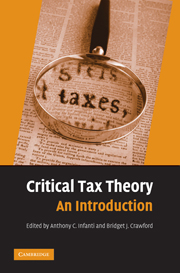Book contents
- Frontmatter
- Contents
- List of Illustrations
- List of Tables
- List of Contributors
- List of Common Abbreviations
- Introduction
- CHAPTER 1 FOUNDATIONS OF CRITICAL TAX THEORY
- CHAPTER 2 HISTORICAL PERSPECTIVES ON TAXATION
- CHAPTER 3 THE GOALS OF TAX POLICY
- CHAPTER 4 CRITICAL TAX THEORY MEETS PRACTICE
- CHAPTER 5 RACE AND TAXATION
- CHAPTER 6 GENDER AND TAXATION
- CHAPTER 7 SEXUAL ORIENTATION AND TAXATION
- CHAPTER 8 THE FAMILY AND TAXATION
- Love, Money, and the IRS: Family, Income-Sharing, and the Joint Income Tax Return
- Innocent Spouses: A Critique of the New Tax Laws Governing Joint and Several Tax Liability
- Taxation and the Family: A Fresh Look at Behavioral Gender Biases in the Code
- The Profits and Penalties of Kinship: Conflicting Meanings of Family in Estate Tax Law
- The Tax Treatment of Children: Separate but Unequal
- Rocking the Tax Code: A Case Study of Employment-Related Child-Care Expenditures
- CHAPTER 9 CLASS AND TAXATION
- CHAPTER 10 DISABILITY AND TAXATION
- CHAPTER 11 GLOBAL CRITICAL PERSPECTIVES ON TAXATION
- CHAPTER 12 CRITICAL PERSPECTIVES ON CRITICAL TAX THEORY
- Index
Innocent Spouses: A Critique of the New Tax Laws Governing Joint and Several Tax Liability
Published online by Cambridge University Press: 04 August 2010
- Frontmatter
- Contents
- List of Illustrations
- List of Tables
- List of Contributors
- List of Common Abbreviations
- Introduction
- CHAPTER 1 FOUNDATIONS OF CRITICAL TAX THEORY
- CHAPTER 2 HISTORICAL PERSPECTIVES ON TAXATION
- CHAPTER 3 THE GOALS OF TAX POLICY
- CHAPTER 4 CRITICAL TAX THEORY MEETS PRACTICE
- CHAPTER 5 RACE AND TAXATION
- CHAPTER 6 GENDER AND TAXATION
- CHAPTER 7 SEXUAL ORIENTATION AND TAXATION
- CHAPTER 8 THE FAMILY AND TAXATION
- Love, Money, and the IRS: Family, Income-Sharing, and the Joint Income Tax Return
- Innocent Spouses: A Critique of the New Tax Laws Governing Joint and Several Tax Liability
- Taxation and the Family: A Fresh Look at Behavioral Gender Biases in the Code
- The Profits and Penalties of Kinship: Conflicting Meanings of Family in Estate Tax Law
- The Tax Treatment of Children: Separate but Unequal
- Rocking the Tax Code: A Case Study of Employment-Related Child-Care Expenditures
- CHAPTER 9 CLASS AND TAXATION
- CHAPTER 10 DISABILITY AND TAXATION
- CHAPTER 11 GLOBAL CRITICAL PERSPECTIVES ON TAXATION
- CHAPTER 12 CRITICAL PERSPECTIVES ON CRITICAL TAX THEORY
- Index
Summary
At the first level, our federal income tax system is one of self-assessment. A taxpayer is required to report items of income, deduction, gain, and loss on a return and compute her taxable income and the tax thereon. The taxpayer must sign and file the return, and pay the amount of tax shown due. The IRS is authorized to review and challenge the self-assessed tax liability, and through administrative and judicial proceedings, the taxpayer may ultimately be found to be liable for a deficiency – the difference between the correct tax due and the amount of tax shown on the return. The deficiency may also include interest charges on taxes paid later than their due date and penalties for failure to self-assess and pay the correct amount of tax due.
A husband and wife who choose to file a joint federal income tax return engage in this self-assessment process jointly. The joint return aggregates items of income, deduction, gain, and loss attributable to either spouse; taxable income is computed in the aggregate, and the tax due is a single amount. If a joint return is made, each spouse undertakes to pay the entire amount of tax shown due. Furthermore, each spouse assumes joint and several liability for the entire amount of any subsequently determined deficiency.
From a collection standpoint, joint and several liability allows the IRS to collect from either spouse the full amount of any deficiency. If the IRS collects the entire amount of a deficiency from one spouse, that spouse has contribution rights against the other spouse for the portion of the deficiency attributable to the other spouse.
- Type
- Chapter
- Information
- Critical Tax TheoryAn Introduction, pp. 231 - 238Publisher: Cambridge University PressPrint publication year: 2009
- 2
- Cited by



